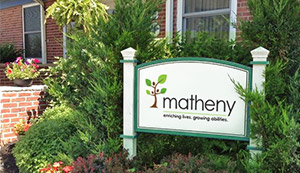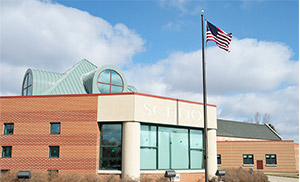Posted on December 16, 2014 by Matheny

Matheny School teacher Peggy Zappulla watches as a visitor to the Matheny booth tries out the adapted baseball pitch game.
Children accompanying their parents at the recent New Jersey Education Association (NJEA) convention in Atlantic City were introduced to the world of adapted sports when they visited the Matheny School exhibit. They were invited to participate in an adapted baseball pitch game, which would be part of a “pitching center” in a Matheny physical education class. Students could throw a ball or grasp and release a ball that was attached to a sklz trainer. The target was the mouth of a bulldog, which is the Matheny mascot.
In addition, a visual and/or physical impairment was added, according to Jim Hintenach, Matheny School supervisor of elementary education. “Some participants covered their eyes; others may have used only one hand or used their thumb, elbows or other body parts to propel the ball, just as our students do.” The idea was to help people understand that students with special needs and all people with disabilities are able to participate in various sports activities, with some adaptions.
The NJEA convention attracts thousands of educators throughout the state who are looking for high-quality professional development and the latest in educational technology.
Posted on November 20, 2013 by Matheny

Sean Bielefeldt, Matheny director of recreation therapy, explains an adapted sports activity to a student visiting the Matheny School exhibit at the NJEA convention.
Visitors to the Matheny exhibit at the recent New Jersey Education Association (NJEA) convention in Atlantic City had an opportunity to experience first-hand what it’s like for children with disabilities to participate in a game or sport. Matheny staff members designed a beanbag toss and invited convention attendees to try it out while sitting in a wheelchair. In addition, the participants had to limit the mobility of their arms or eliminate use of their arms altogether. Or they had to cover one or both eyes.
“I think many people walked away with more appreciation for students with special needs,” said Cindy LaBar, Matheny’s director of physical therapy. “It also helped them to understand that our students and all people with physical disabilities are able to participate in activities just like they do, with some adaptations. We explained that our students can ride a bike, go for a walk and even throw a football. There seemed to be a great deal of interest among public school teachers and therapists about how we adapt physical activities.”
The NJEA convention attracts thousands of educators from throughout the state who are looking for high-quality professional development and the latest in educational technology.





